
Shedding Light on the Tyre Affair
Atlas F1 Editor in Chief
The latest controversy around the Michelin front tyres' tread width seemed to have subsided over the Italian Grand Prix weekend, but none of those involved believe the last word has been said on the matter. Biranit Goren digs deeper into the affair, offering new information never published before. Exclusive for Atlas F1
Dennis was seated at the front row of the press conference table on Friday afternoon at Monza. To his left was Ferrari's technical director, Ross Brawn. Behind them were Williams's technical director Patrick Head and Renault's team chief Flavio Briatore. Three Michelin-shod teams versus one Bridgestone-shod representative. The odds were never going to be in Brawn's favour.
Two weeks before, on August 29th, a slow news day by all accounts - seeing as the second 3-week break of the season had just begun, following the Hungarian Grand Prix - the news of Michelin's front tyres coming under scrutiny erupted in full force. The gist of it suggested the tread width on the front Michelin tyres can, under certain conditions, expand beyond 270 milimetres as allowed in the FIA's 2003 Sporting Regulations.
All of a sudden, every Formula One fan and every news reporter became a lawyer for the day, analysing the regulations in an attempt to understand what Michelin had done wrong, or why their tyres may be disqualified. The FIA, in turn, sent the teams a letter two days prior, on Wednesday, August 27th, advising them that the tyres' tread width would thereafter be measured on used tyres. Previously, the tread width was measured only on new ones.
It came at a crucial point in the World Championship, seeing as Ferrari lost their lead in the Constructors' standings at Hungary to Williams, and that Ferrari's Michael Schumacher was holding a slender lead of one point ahead of Williams's Juan Pablo Montoya and another point ahead of McLaren's Kimi Raikkonen in the Drivers' World Championship.
Since Williams and McLaren are both running on Michelins whereas Ferrari run on Bridgestone, the immediate reaction of fans and media alike was to assume the FIA has intervened in favour of Ferrari. The view was more so enforced when, four days later on September 3rd, Ferrari admitted they were the ones to tip off the FIA about the Michelin tyres. The verdict was simple: Ferrari don't know how to lose and the FIA is biased in favour of the Italian squad.
"I think there is every opportunity for the media to effect its own judgement and I think they're effecting it on factual information," Dennis continued on that Friday press conference in Monza, measuring every word. "I think the media response was appropriate."
The media's response, if to judge by the Friday press conference, was an onslaught on 'sore losers' Ferrari - the dominating World Champions from last year who cannot come to terms with their superiority diminished on track, so they turn to politics to sort it out in board rooms and court cases.
The problem is, perception can be misleading, and more so in this case. Not all facts in this affair are known to all, as Dennis suggests, and just like the core issue itself - that of tyre tread width - even the little known is open to interpretation. Moreover, the most crucial information was not made available to the fans and media - and it is with that in mind, that Atlas F1 takes a deeper look into this latest tyre affair.
Before Michelin entered Formula One in 2001, the French tyre company was already complaining about the ambiguity of the Sporting Regulations, although back then the French were primarily concerned with the issue of grooved tyres, not tread width. In the 2000 French Grand Prix, the company's sporting director Pierre Dupasquier told reporters that the FIA's rules require four grooves but do not specify the maximum depth of the groove or the depth of the groove at the end of a race.
"We think this is an important question," he said back then, "because ever since there has been just one tyre manufacturer in F1 there seems to have been a gentlemen's agreement about the [state of the] tyres at the end of the races. Nobody pays attention to the shape of the poor things at the end of the races. But in most cases the races finish [with the cars] running on what are almost slick tyres.
"This is therefore a question for the tyre suppliers, and Mr. Yasukawa [of Bridgestone] and I have put a question to the FIA about specifying [the limits] to make sure that there will be no question of races having to be decided the following day on the basis of post-race tire checks, because that would be ridiculous...
"Nobody wants to see a driver winning a Grand Prix and drinking the champagne, only for someone to say two hours later that he is to be disqualified because there was too much wear on his tyres. That makes no sense. We are desperately trying to find a way. But if we don't succeed, then we will protest the results of every race."
In all fairness, the issue of tread width was not even thought of at that point in time. It was only before the 2001 San Marino Grand Prix, when Michelin were about to introduce a new tyre mould - a wider tyre than before - that they looked at the regulations and asked the FIA to clarify their intent.
Article 77c of the Sporting Regulations states:
"Our interpretation is that tread width should be under 270mm in the beginning and after the race as well. This is Bridgestone's interpretation," states Bridgestone's technical manager, Hisao Suganuma.
Michelin held a different view.
"It was not only a matter of interpretation," Dupasquier explains. "With the FIA we used to work very closely to make sure that the way we behave will be perceived by the FIA as within the rules.
"When we read the 77c article, we said to the FIA - 'how are you going to measure it, the 270mm?' They said, 'well, we didn't make anything clear so far, what do you suggest?' We said, 'it's up to you. Just let us know the way you will check and measure and we will behave accordingly' - since in F1 no one gives up even one percent in any way; everybody is absolutely at the limit everywhere, that's the game.
"So they said, 'what do you suggest?' And we said, 'well, it's very, very difficult to measure [tread width] on worn tyres - it's very complicated to see anything, we don't see how you can police it. On new [tyres] it's easy - we make on purpose the tread visible and that can be measured'. That was before we came up with the tyre on the very limit, in Imola 2001."
What Dupasquier is saying, however, is that both Michelin and the FIA were looking at feasible ways to measure the tread width. Never did Michelin ask the FIA - and never did the FIA need to address the question of whether a measurement procedure also dictates the limitations of that very measurement.
In other words, Michelin took the FIA's decision to measure tread width when new to suggest the tread width of a used tyre is irrelevant. It can be less than it was when new, it can be more. In fact, Dupasquier doesn't even know if their front tyres' tread width was ever wider than 270mm in previous years - it never occurred to him that this could be an issue.
"But they also said, 'let us think about it - we'll come back to you over the week'. Which is fine, they should do whatever they want - I said we will comply to whatever they say - but I was not thinking for a second that anybody can change a technical rule of the definition of the tyre size... if you change the way you measure it, since we are at a hundred percent, it means necessarily [changing] a tyre definition."
Q: Yes or no, was your tyre's tread width wider, after use, than 270mm last year?
Dupasquier: "I did not check."
Q: You never checked this?
Dupasquier: "No."
Q: It was never an issue before?
Dupasquier: "Absolutely not. We did not check it. My first reaction when Charlie said after Hungary that they measured it was, 'so what? What are you talking about?'"
Q: You didn't think that it might be wider?
Dupasquier: "It could be, but so what? We don't build a tyre on purpose to be wider when in use!"
Q: The implication was that you found a loophole in the regulations that gave you an advantage, yet you're telling me that it wasn't even a conscious choice?
Dupasquier: "Even if we had that intention, it will play on a few milimetres - which definitely has nothing to do with the performance."
Bridgestone too admit the tread width of the Michelin front tyres was never an issue, nor that they suspected or looked into it prior to this season.
"I believe it was never an issue before, I don't think so," Bridgestone's Suganuma says. "Of course, as you know, our tyre shape and Michelin's tyre shape is different so it seems the Michelin tyres are bigger than ours. [...] We investigated how to make those tyres, but so far we couldn't find the solution. Of course, Bridgestone respect the Michelin tyres company, so after this crisis we are a little bit surprised."
Q: Why were you surprised?
Suganuma: "Because the interpretation is different, and because they now say the laws are not clear."
The turning point was after Monaco this year, when Michelin introduced a new tyre compound and Williams began to set up their cars to favour the tyre - rather than sacrifice tyre width in favour of aerodynamics. In fact, Dupasquier acknowledges that rather than the tyre changing, the setup of the car allowed for a new and better exploitation of the front tyres' contact patch.
"We believe that the whole machine has one aim - and it's to use the best possible way a small piece of rubber that you present to the ground," he says. "At the end of the day, that's what it is. So that's a complete attitude. Ferrari did differently - they preferred aerodynamics over tyres - and we tried that too, those narrow tyres, and it appeared that the global package is less performing like that. Although, it depends where and how.
"There are significant differences in the tread width just based on the setup of the cars - weight distribution, camber setup, toe in, toe out - it can, on some occurrences, make differences."
"After Monaco," Suganuma recalls, "it seemed our competitor tyres' performance is better than ours. Ferrari and BAR demanded from us to make [a tyre in] the same shape as Michelin. We tried, but we realized the result would be a tread width wider than 270mm and we couldn't do it like that because our interpretation [of the rules] is a little bit different than Michelin's."
It was, Suganuma admits, the first time they had to consider the issue of article 77c - and the first time they realized, without real proof though, that the Michelin front tyres have, on occasion, a tendency to end up with a wider tread width than what Bridgestone assumed was allowed.
"We began watching the Michelin tyres carefully - taking photos from time to time," Suganuma continues. "But unfortunately we couldn't, before Hungary, get a clear picture of the tyre after the race. We had pictures during the race - but that is not good enough to measure the tread width.
"The problem we had was that recently Parc Ferme (where the cars park after the race is over and await scrutineering) was inside a garage - there was no way of getting pictures inside it.
"But in the Hungaroring the Parc Ferme was, for the first time [since Monaco], outdoors, beside the garage. In fact, it was located right in front of the tyres working area. Michelin on one side, Bridgestone on the other - and Parc Ferme right in the middle. So everybody could watch the tyres and every photographer could get a clear picture of the used tyres on a car standing still.
"So we collected photos from photographers we know and we checked the photos immediately after the race. It (the tread width) was apparently different. I took those photos to Mr. Ross Brawn and told him, that is why we couldn't find the space to develop tyres like the Michelins."
Q: So you were simply doing this to explain to Ferrari why you can't do the same as Michelin?
Suganuma: "That's right."
Regardless of Bridgestone's motives, Ferrari obviously had other ideas in mind. When your rivals discover a new advantage, you can either try to copy or match that advantage, or you can challenge its legality. As Bridgestone were unwilling or unable to match Michelin's advantage, Ferrari decided to challenge it.
At the end of the day, the one piece of information unknown to the public until now is what cars were found to have an oversized tread width after the Hungarian Grand Prix. Were all Michelin runners sharing the same trait? Was this, indeed, an issue pertaining exactly half of the grid?
"Well, it really depends on the car," Dupasquier says. "In Hungary, we did not check them, all of them, carefully - the FIA did. We've been told [by Charlie Whiting] that particularly the Williams was a bit wider - 276mm - yet the Renault was absolutely within the 270mm. Interestingly, the one car lapping Michael Schumacher was Renault - [Fernando] Alonso's car in Hungary, after the race, has been reported to be within the 270, and he won, lapping Michael! So they'll (Ferrari) have to find another argument [to explain why they lost] because this one (of tread width) doesn't stand!"
Q: Did you send a photographer to take pictures for you?
Suganuma: "No, but if a photographer takes photographs of the tyres they give us those photographs. It is not a specific case, it's always like that - sometimes photographers help us with design ideas, not just about dimensions but also, for example, if we can get photographs [of the Michelin tyre's behaviour] during the corner, then in that case maybe we can check lateral stiffness or something like that, so it is normal."
Q: In Hungary, the pictures that you got after the race from Parc Ferme - your proof - of what team was it?
"I believe..." Suganuma hesitates, before replying: "I believe it was Toyota."
When Dupasquier hears that the pictures Bridgestone held were of Toyota, he laughs.
"Toyota, like Renault, is among the cars whose tread width after Hungary was found by Charlie [Whiting] to be within the 270mm," he exclaims. "It's important, because if they say that this was their proof, then they say rubbish! I'm serious! I told you that the Williams was wider - but not the Toyota and not the Renault and not the Jaguar."
Bridgestone are adamant that tread width could be measured from photographs, provided the image is clear and the car is at stand-still, rather than in motion. "If the tread isn't used, it still shines," Suganuma explains, "but once used the color is apparently different."
Q: So you put these images into a computer and get measurements like that?
Suganuma: "yes, that's right."
Surely it doesn't get any more ironic than that! Bridgestone suspected - rightly, as it turns out - that the Michelin front tyres' tread width can expand beyond 270mm after use; yet they came up with the wrong evidence, only to have Charlie Whiting inspect the suspicion and find it correct - on a different car.
There is no reason to suspect Bridgestone are not telling the truth, but the options are really minimal: either their Toyota proof was simply wrong, or they know more than they are sharing with us.
The bottom line, however, remains the same: the most important rival for Ferrari was found by the governing body to have oversized tread width - and that is Williams.
It's very tempting to see the FIA's actions in this latest affair as a result of bias in favour of Ferrari. In reality, though, a deeper look might suggest the FIA did everything but help Ferrari.
Imagine this hypothetical scenario, long before this latest affair came to light: Michelin or Bridgestone are working on a new tyre mould or construction. They contact the FIA technical delegate, Charlie Whiting, and inquire whether the FIA would allow them to create a front tyre whose tread width expands, deliberately, once in use. In other words, would it be legal to create a tyre whose tread width is within the allowed 270mm when new, but would thereafter expand to beyond that measurement?
Whiting's response would have to be No.
"I agree with you," Dupasquier says when presented with this hypothetical question. He agrees, because the ramifications of the FIA allowing any dimension to expand beyond its initial size once in use are dangerous and leave the door wide open for a tyre that is nowhere near the one presented when new.
"Absolutely," Dupasquier says. "Well, the door will not be wide open - because you cannot start with 270mm when new and end up with 290mm or anything like that, it doesn't make sense. But they would be obliged to say, 'no, the intention is not to use a wider tyre'."
If Dupasquier agrees with this, common sense suggests the FIA had no other choice than to send the letter they sent on Wednesday, August 27th, to the teams.
Once presented with the clear fact that some tyres do have a wider tread width than allowed, the FIA had no other choice than to make such a clarification, it's as simple as that.
In fact, if the FIA had any other choice - it was to disqualify those cars whose front tyres' tread width was found beyond 270mm in Hungary. It would be safe to say that this is even what Ferrari expected them to do.
"But they'd have to protest, No?" Dupasquier asks. "Ferrari did not protest, so how could the FIA disqualify us?"
But, more to the point, witness the 1999 Malaysian Grand Prix: the FIA technical delegates at Sepang received information, unofficially and without a protest, from McLaren that the Ferrari barge-boards did not conform to the dimensions stipulated by the regulations. The scrutineers followed up on that information - just as Charlie Whiting did in Hungary with the Ferrari information on the Michelin tyres - and found it to be correct; the barge-boards were indeed oversized - just as Whiting discovered the tread width of the Williams tyres to be oversized.
In Malaysia 1999, McLaren's unofficial information and the FIA's subsequent scrutineering lead to the disqualification of Ferrari (albeit it being reversed in an appeal a week later). It is important to remember that the disqualification did not stem from any official protest made by any of the rival teams.
In Hungary 2003, the information and subsequent scrutineering could have equally lead to the disqualification of Williams, seeing as the FIA hold the belief that tread width must not be wider than 270mm. But rather than disqualify any team, the FIA elected to make a clarification pertaining to future races. No one was disqualified, no investigation was opened by the stewards.
Again: considering the FIA had no other choice than to make it clear the tread width cannot be wider than 270mm after use, and considering the Michelin tyres were found to be wider than 270mm - then there were only two courses of actions: either disqualify these cars, or make sure it doesn't happen again.
And you can be sure the latter option was the least favourable to Ferrari.
When Ferrari owned up to tipping the FIA off, Ross Brawn said: "We could have pretended to have seen nothing, to not let the FIA know and then lodge a complaint at the following race, but that didn't seem like the right thing to do."
With all due respect to Brawn, that is patently deceiving. If Ferrari really just wanted a clarification and were trying to do "the right thing", Jean Todt would not be talking right now about the possibility of appealing previous races. It is that fact alone which suggests Ferrari gave the FIA the information with the hope of having their rivals disqualified.
And the fact is, the FIA did not comply with that. The governing body did the only sensible thing for all involved: leave the Championship on track and make sure the rules are clearer for the future's sake.
"This affair is not over," Dupasquier says. "Don't underestimate Jean [Todt] - he will never, ever give up. I know him for a long time. They don't want to lose the Championship. One way or another."
In other words, as Dupasquier says, if Ferrari lose the World Championship they may well elect to protest the results of past races.
Article 179b of the FIA's 2003 Sporting Code allow Ferrari to do so. "If, in events forming part of a FIA Championship, a new element is discovered, whether or not the stewards of the meeting have already given a ruling, these stewards of the meeting or, failing this, those designated by the FIA, must meet on a date agreed amongst themselves, summoning the party or parties concerned to hear any relevant explanations and to judge in the light of the facts and elements brought before them," the Code states, adding that: "The period during which an appeal in review may be brought expires on 30 November of the current year."
Nevertheless, can Ferrari realistically win a protest against results of past races?
When presented with that question last week, a source close to the FIA said: "It is inconceivable that a right of review would be successful because of a significant lack of evidence."
The main evidence missing is, of course, the tyres themselves - not to mention that the measurements of the tread width largely depend on the car's setup and how these tyres are positioned on the car at measurement. Moreover, neither Bridgestone nor Michelin store the tyres after races - they are shredded to unrecognised mush, not even thrown out in a normal garbage bin for fear of industrial espionage.
But the point that seems to go amiss with everyone involved is the fact that Ferrari don't need to protest all past races. They don't even need the tyres. The evidence they require already exists. At least, according to Dupasquier.
"After Hungary, [the FIA delegates] checked the tyres after the race," Dupasquier says. "They called us up and they said 'we think that the tyres look to be used with a tread width wider than 270mm'... We did not check [the tyres], all of them, carefully - but the FIA did."
So the FIA had already inspected "carefully" the Michelin tyres after Hungary, and - as Dupasquier himself admits - found "that particularly the Williams was a bit wider - 276mm."
If that is indeed the case, that is all the evidence Ferrari needs.
If - and that remains a valid argument for legal minds - the tread width must not be more than 270mm at all times, and if Ferrari are able to convince a court that article 77c could not be interpreted any other way (which is indeed a matter of argument) - if that argument can be won, Ferrari don't need any evidence. The FIA and Michelin already know and admit that the tread width was wider in Hungary.
Williams scored 11 points in Hungary. They moved to the lead of the Constructors' Championship by eight. Moreover, disqualifying Juan Pablo Montoya (who finished 3rd) and Ralf Schumacher (in fourth), would elevate Michael Schumacher two places (from eighth) and award Ferrari and himself an additional two points lead.
13 points are therefore at stake, and considering how close both Championships are currently run between Ferrari and Williams, 13 points is more than enough to decide this World Championship in Ferrari's favour.
If Ferrari lose the World Championship this year, this is therefore all they would need to do: challenge the Hungarian Grand Prix results, and de facto challenge the FIA's decision in that race not to disqualify Williams despite finding their tread width to be wider than 270mm after use.
And what will the FIA do then?
Whiting will have to admit in court that, indeed, he measured the Williams front tyres' tread width and found it in excess of 270mm.
If that is the case, Ferrari's lawyer will ask Charlie Whiting, then why did you not disqualify the Williams cars immediately upon measuring them and finding out their tread width is oversized?
There will be no need for physical evidence; there will be no need for photographs.
If oversized tread width was against the rules, then Michelin has already confessed and Whiting had already taken measurements.
That is all Ferrari would require.
Contrary to common belief and unlike the concentrated Public Relations spin that has been coming out of the Michelin camp, the Italian Grand Prix at Monza was not the test for Michelin's ability to adapt to the new conditions, nor to the FIA's procedure of measuring tread width after the race.
Monza was not the test, simply because Michelin had already prepared a narrower tyre compound for this low downforce, high speed track - and they were working on it before the whole controversy even began.
"We already had narrow tyres prepared for Monza - not narrow in the mould, narrow in the construction - because of the condition of Monza," Dupasquier explains. "So after Charlie's letter, we only modified a little bit the way the sidewalls are joined to the tread. That's all."
Q: So if those tyres had already been prepared for Monza before this affair broke out, what is going to happen with the construction for Indy and Suzuka? Aren't you now facing the same problem?
Dupasquier: "Exactly. We'll see if they disqualify us [there] or not."
Dupasquier says the problem remains over how exactly the tyres will be measured. Charlie Whiting's letter to the teams, of August 27th, stated that: "it has become clear that under certain circumstances the total front tyre contact patch on some cars can exceed 270mm in width, despite the fact that when measured statically on a new tyre the apparent tread width does not exceed the maximum stipulated in the sporting regulations.
"With immediate effect, any part of a front tyre which we consider has been in regular or systematic contact with the track will be deemed tread and will be taken into account when measuring the width of the tyre as defined in the regulations."
Dupasquier remains adamant that Whiting's clarification needs, in itself, to be clarified. "What we couldn't accept was the words, 'with immediate effect' - this legally means something new, starting from now," he says. "And then the words stating 'the part of the tyre that we consider...' How can we base a design and construction and millions [of dollars] of investment on the consideration - the philosophical consideration - of a man, whoever it is, that would say 'hmmm, I think that maybe the tyres are too wide'. Oh my goodness, it doesn't stand in front of any good sense!
"The front tyre in particular is never on the ground permanently. You get positive camber - the inside of the tyre is up in the air; you get negative camber on the straight - the outside of the tyre doesn't think of touching the ground. So obviously that's not the point. What we did is to optimize our width according to what we knew; we agreed with the FIA that tyres will be measured when new, to make sure that what will be measured will be within the 270mm.
"But the problem now is that even if we have a different understanding with the FIA, it's permanent - the FIA came here every day and measured the tyres after use. In fact, we supplied them with tools to measure it! So we don't even know what tools they will use to measure the tyres after the race in Indy or Suzuka. How can we prepare a tyre based on that??"
Michelin will, no doubt, come up with a solution. Considering the tread width largely relies on the car's setup, as Dupasquier himself admits, then the French company need not even come up with a new compound; it would simply be up to their teams to alter the setup of the car so as to ensure the front tyres' tread width remains within the allowed 270mm, even after the race.
In their last official statement on this affair, from September 9th, the FIA concluded the matter in saying: "With hindsight, it is regrettable that those using the earlier Michelin front tyres did not consult the FIA about possible excess tread width as soon as they became aware of it.
"However, as far as the FIA technical department is concerned, the matter is now closed and the Championship can continue with all teams on an equal footing."
Whether the matter is indeed closed for the FIA - seeing as the Michelins still need to pass scrutiny in the next couple of races and Ferrari still need to decide whether or not to protest previous results - remains to be seen.
But with allegations thrown both ways (and Michelin are not about to sit tight, they are already collecting data about the opposition as well) and threats of libel lawsuits made by those involved, don't be so sure that the 2003 Formula One World Championship will continue to run only when the rubber meets the ground.
"This," McLaren's Ron Dennis began to talk, responding to a question about the latest tyre controversy, "this is one of the very rare occasions in motorsport where all the facts - and the timing of what took place and when - are well known to everybody."
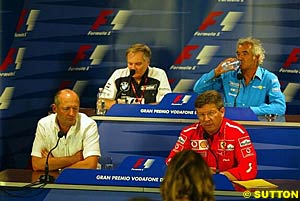 It was epitomized in an exchange - somewhat lost on the microphone - between a visiting journalist from Hong Kong, who asked Patrick Head if he remembered the FIA ever interpreting a rule not in favour of Ferrari. When Ross Brawn cut in to respond to the alluded accusation of favouritism, the journalist simply told him to be quiet and wait his turn. The level of animosity was verging on a lynch.
It was epitomized in an exchange - somewhat lost on the microphone - between a visiting journalist from Hong Kong, who asked Patrick Head if he remembered the FIA ever interpreting a rule not in favour of Ferrari. When Ross Brawn cut in to respond to the alluded accusation of favouritism, the journalist simply told him to be quiet and wait his turn. The level of animosity was verging on a lynch.
What is the fuss all about?
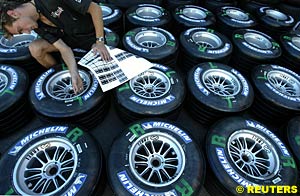 Back then, the FIA left the issue of grooved tyres after use open to future review, stating in the Sporting Regulations that "The Championship will be contested on grooved tyres. The FIA reserve the right to introduce at any time a method of measuring remaining groove depth if performance appears to be enhanced by high wear or by the use of tyres which are worn so that the grooves are no longer visible."
Back then, the FIA left the issue of grooved tyres after use open to future review, stating in the Sporting Regulations that "The Championship will be contested on grooved tyres. The FIA reserve the right to introduce at any time a method of measuring remaining groove depth if performance appears to be enhanced by high wear or by the use of tyres which are worn so that the grooves are no longer visible."
Each front dry-weather tyre, when new, must incorporate 4 grooves which are:
- arranged symmetrically about the centre of the tyre tread;
- at least 14mm wide at the contact surface and which taper uniformly to a minimum of 10mm at the lower surface;
- at least 2.5mm deep across the whole lower surface;
- 50mm (+/- 1.0mm) between centres.
Furthermore, the tread width of the front tyres must not exceed 270mm.
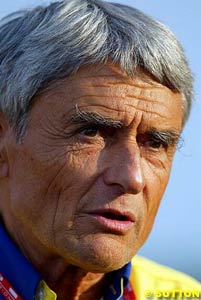 "They called us up [after the Hungarian race] and they said 'we think that the tyres look to be used with a tread width wider than 270mm'," Dupasquier continues. "I said, 'maybe, so what? So?' I asked them - the two technical delegates - 'do you remember that when we asked the question when and how you measure it, we agreed that it would be on new tyres?' They said 'yes'. Both of them. I told them, 'did you validate it any time before races?' They said, 'yes'.
"They called us up [after the Hungarian race] and they said 'we think that the tyres look to be used with a tread width wider than 270mm'," Dupasquier continues. "I said, 'maybe, so what? So?' I asked them - the two technical delegates - 'do you remember that when we asked the question when and how you measure it, we agreed that it would be on new tyres?' They said 'yes'. Both of them. I told them, 'did you validate it any time before races?' They said, 'yes'.
Why did Ferrari wait until Hungary?
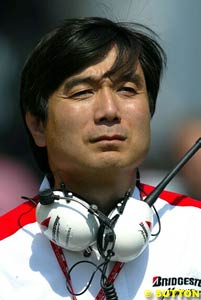 Williams exploited that difference well. Since winning the Monaco Grand Prix this year, and through the Hungarian Grand Prix - a total of seven rounds out of 13 - Juan Pablo Montoya scored 56 of his then 71 World Championship points, and Ralf Schumacher scored 38 of his 58 World Championship points. In total, Williams scored 94 points in nearly half the races.
Williams exploited that difference well. Since winning the Monaco Grand Prix this year, and through the Hungarian Grand Prix - a total of seven rounds out of 13 - Juan Pablo Montoya scored 56 of his then 71 World Championship points, and Ralf Schumacher scored 38 of his 58 World Championship points. In total, Williams scored 94 points in nearly half the races.
So which cars were found to have a wider tread width?
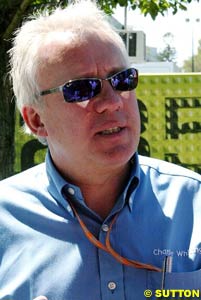 Interestingly, and perhaps ironically, Bridgestone had no proof regarding the Williams cars in Hungary. When Atlas F1 asked Bridgestone's technical manager Hisao Suganuma if their evidence on the tread width was conclusive for all Michelin runners, he replied: "On this point - we don't know. We got only this restricted number of photographs - we didn't get photographs for every Michelin runners."
Interestingly, and perhaps ironically, Bridgestone had no proof regarding the Williams cars in Hungary. When Atlas F1 asked Bridgestone's technical manager Hisao Suganuma if their evidence on the tread width was conclusive for all Michelin runners, he replied: "On this point - we don't know. We got only this restricted number of photographs - we didn't get photographs for every Michelin runners."
 Ron Dennis actually addressed this very issue at the Friday press conference, and based on the above, he may just be spot on: "The reality is that the observations are always based on photographic evidence and the photographic evidence was always of contaminated tyres," he explained, adding that "One of the issues you have with racing tyres is the fact that they pick up rubber, inevitably on a slowing down lap when the cars tend to drive off line."
Ron Dennis actually addressed this very issue at the Friday press conference, and based on the above, he may just be spot on: "The reality is that the observations are always based on photographic evidence and the photographic evidence was always of contaminated tyres," he explained, adding that "One of the issues you have with racing tyres is the fact that they pick up rubber, inevitably on a slowing down lap when the cars tend to drive off line."
Did the FIA try to help Ferrari?
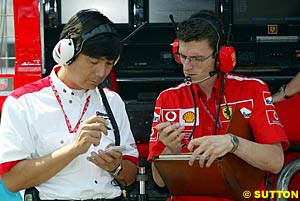 That is a rather common misconception - that the FIA would require an official protest from one of the teams to investigate and subsequently alter results. But the truth is, the FIA doesn't need a protest to do that. In Brazil this year, they declared a different winner to the race a few days later based on an independent investigation - without Jordan protesting. In Germany this year, the stewards penalised Williams's Ralf Schumacher based on Charlie Whiting's decision - there was no complaint from Ferrari or McLaren.
That is a rather common misconception - that the FIA would require an official protest from one of the teams to investigate and subsequently alter results. But the truth is, the FIA doesn't need a protest to do that. In Brazil this year, they declared a different winner to the race a few days later based on an independent investigation - without Jordan protesting. In Germany this year, the stewards penalised Williams's Ralf Schumacher based on Charlie Whiting's decision - there was no complaint from Ferrari or McLaren.
Does Ferrari have a case for a retroactive review of past races?
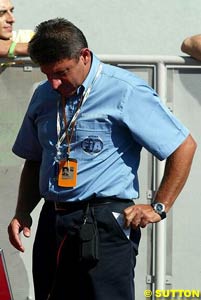 Ferrari's sporting director Jean Todt seems to agree with that view. "It's a possibility which is open to us," Todt told Atlas F1's Will Gray. "We can [file a protest over past races] until the 30th of November. We prefer to win on the track but then how could I lower myself to tell you if we can win it? First we need to decide if we decide to apply this possibility and then challenge."
Ferrari's sporting director Jean Todt seems to agree with that view. "It's a possibility which is open to us," Todt told Atlas F1's Will Gray. "We can [file a protest over past races] until the 30th of November. We prefer to win on the track but then how could I lower myself to tell you if we can win it? First we need to decide if we decide to apply this possibility and then challenge."
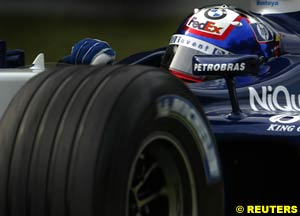 More importantly, he will have to also admit that the FIA does not consider article 77c to suggest the tread width could expand even if it was measured only when new. Remember what the FIA said in a statement on September 9th: "A number of press reports have suggested that the FIA has changed or re-interpreted the tyre regulations. This is not correct. The maximum tread width has been 270mm since 1999. The FIA has never suggested that tread width was unlimited once the tyre was in use."
More importantly, he will have to also admit that the FIA does not consider article 77c to suggest the tread width could expand even if it was measured only when new. Remember what the FIA said in a statement on September 9th: "A number of press reports have suggested that the FIA has changed or re-interpreted the tyre regulations. This is not correct. The maximum tread width has been 270mm since 1999. The FIA has never suggested that tread width was unlimited once the tyre was in use."
How will this affect the rest of the WC?
Please Contact Us for permission to republish this or any other material from Atlas F1.
|
Volume 9, Issue 38
Atlas F1 Exclusive
Ground Rules
Q&A with Paul Stoddart
View from the Paddock
2003 Italian GP Review
2003 Italian GP Review
Three Years Later
Stats Center
Qualifying Differentials
SuperStats
Charts Centre
Columns
On the Road
Elsewhere in Racing
The Weekly Grapevine
> Homepage |